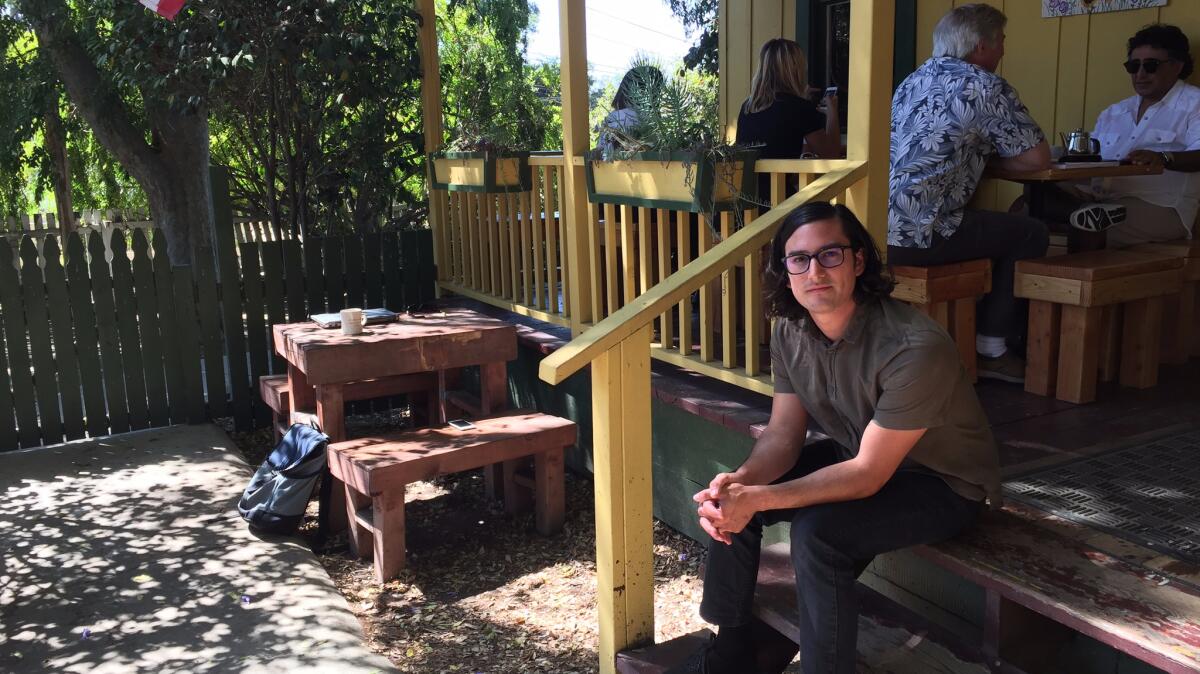Marijuana: A potent disruptor for young users, whose brains are still developing

- Share via
Reporting from San Juan Capistrano — Devan Fuentes made it all the way through San Clemente High School without drinking or using drugs. He vividly remembers the first time he smoked pot. He was visiting a friend at Occidental College, and decided the moment had come.
“They brought out a giant three-foot bong,” Fuentes told me the other day in a rustic coffee shop tucked into this town’s historic Los Rios neighborhood. “I heard a lot of people don’t get high their first time, so I held it in for a long time, one large hit. Immediately, I couldn’t feel my legs.”
This was not an entirely unpleasant sensation for Fuentes, 23, who described his younger self as quiet, prone to depression and even “sort of an outcast.”
Pot made him feel more extroverted.
“And that,” he said, “kind of opened the door.”
Hoping to launch a music career, he moved with friends to Oakland in the summer of 2012.
“But my focus wasn’t on music and meeting people,” he said. “It was on making enough money to get by, and smoking.” He worked at a Starbucks and a Japanese restaurant. He got to know the local cannabis dispensaries, where, eventually, he was spending between $120 and $160 each week.
In March 2013, less than a year after moving north, he crashed.
He vividly remembers the moment he was in full-blown psychosis: “I was thinking so hard, my mind started traveling so fast, until I experienced a big, bright light flashing in front of my eyes, like being shot from the base of the Earth into the universe, to outer space, and then coming to a final epiphany. And then I am back inside my body, and I start running around my room to find pieces of paper to write on.”
Terrified, he called 911. “I feel schizophrenic,” he told the dispatcher. “I am afraid I am going to hurt myself.”
Could pot have triggered Fuentes’ psychosis? Or could it have exacerbated an underlying predisposition to mental illness?
::
As Californians ponder whether to vote for Proposition 64, the November ballot initiative that would legalize marijuana for adult use, it’s important to own up to the fact that marijuana is not always the benign bud that many advocates would have us believe, particularly for teens and young adults, whose brains are still developing.
Proposition 64 proposes safeguards against sales to those under 21, but the minimum age for obtaining a doctor’s recommendation for medical marijuana is 18, and that will not change with legalization. Opponents say delivery services such as Eaze, which have sprouted all over the state, will make it easy for minors to skirt the law.
And yet, in states such as Colorado, where recreational marijuana was legalized in 2012, there does not appear to have been a spike in teen use. A 2015 survey by the Colorado Department of Public Health found that 21.2% of Colorado high school students reported using marijuana the previous month, a rate slightly below the national average of 21.7%. (There are some reports that show higher use.)
Still, apart from some very specific medical uses for conditions such as childhood epilepsy, kids have no business using pot, especially today’s stuff, which is way more potent than it used to be.
“We have a child/adolescent unit that treats kids to age 17, and an adult unit for 18 and older, and we see young people in both age groups who come to the emergency room with florid symptoms of psychosis that appear to be associated with heavy use of marijuana,” said Tom Strouse, medical director of UCLA’s Resnick Neuropsychiatric Hospital. “Sometimes they have a known, preexisting illness, but many do not.”
Marijuana, he said, can cause psychosis. For some, it will be fleeting. But for those with a genetic or biological risk for a chronic illness such as schizophrenia, Strouse said, “heavy marijuana use may hasten or intensify the manifestation, and lead to a worse course than if you never used marijuana at all.”
Strouse’s colleague, Mark De Antonio, director of Resnick’s Inpatient Child and Adolescent Psychiatric Service, often sees young patients who are having what he called “a brief psychotic reaction” to pot.
“They are intoxicated, and may be hallucinating,” De Antonio said. “They become anxious, and incredibly confused. It’s not life-threatening. We don’t see that many kids that require hospitalization just because they are stoned out of their minds.”
Still, both De Antonio and Strouse, who has no problem with his cancer patients using marijuana for nerve pain, said they worry about the toll that pot takes on developing brains.
“It’s clear that acute intoxication impairs learning and memory, and if you are stoned every day as a high school student, you will be less good as a student,” said Strouse.
“The conservative, safe answer is that kids should avoid marijuana,” said De Antonio. “The realistic answer is probably that intermittent use of marijuana — and I mean intermittent, like monthly — is not going to be harmful. But if you ‘wake and bake’ — use it when you wake up and all day till you go to sleep — I don’t think good things come from that.”
::
After his psychotic break, Fuentes ended up hospitalized for nearly two weeks.
Before that, he said, he’d been smoking pot constantly and drinking as much as a whole pot of coffee a day. He had also experimented with salvia, a psychoactive plant, and magic mushrooms.
There had been warning signs; for a couple of months, he said, he’d been having what he described as “pre-psychotic symptoms,” which included delusions, manic behavior and disassociation. He was diagnosed with schizoaffective disorder, and he has been slowly tapering off mood-stabilizing medication.
Now sober for about two years, he’s decided to talk about his experience, to destigmatize mental illness but also to help others understand the role that psychoactive drugs may have played in his deterioration.
He does not entirely blame cannabis for his psychosis. But, he said, “pot definitely played a part.”
As we face the possibility of plunging headlong into the brave new world of recreational marijuana, we have to be certain that the barriers to teen and adolescent use will be high, no pun intended.
In the next few weeks, I’ll be taking a close look at how the Adult Use of Marijuana Act proposes — paradoxically — to make it harder for kids to get their hands on pot, while making it easier for everyone else.
Also
Latinos hold key to pot legalization, but will they share its riches?
Why California voters will probably legalize pot in November
Oakland museum’s marijuana exhibit: Go ahead, touch that bud!
Twitter: @AbcarianLAT











